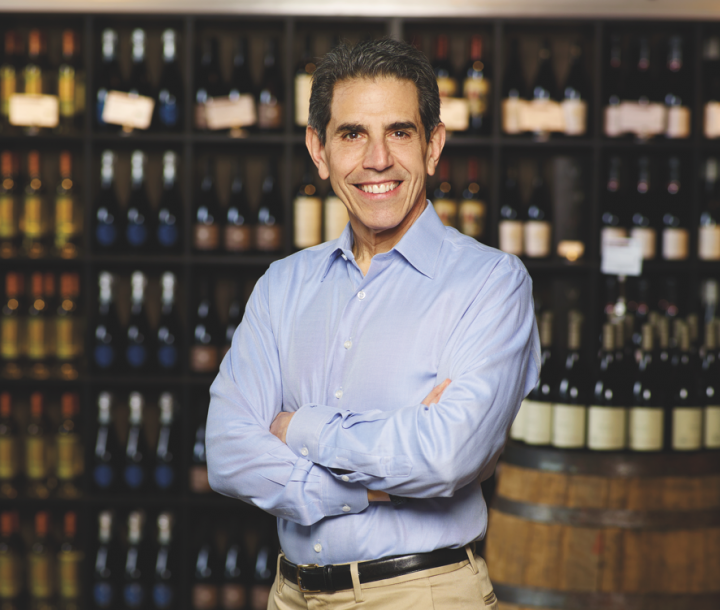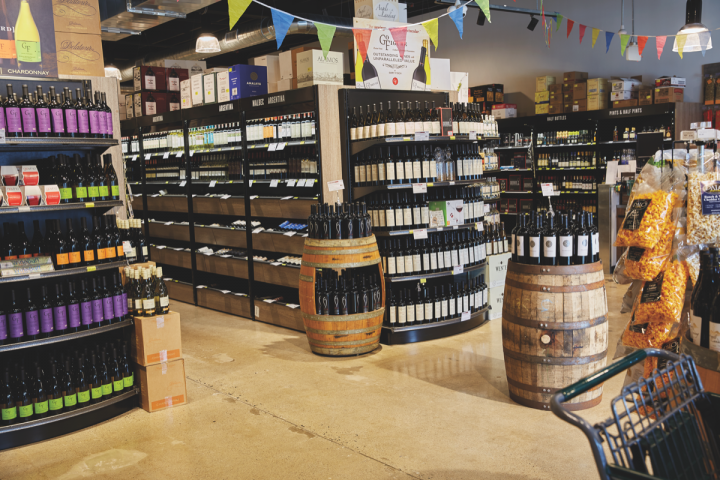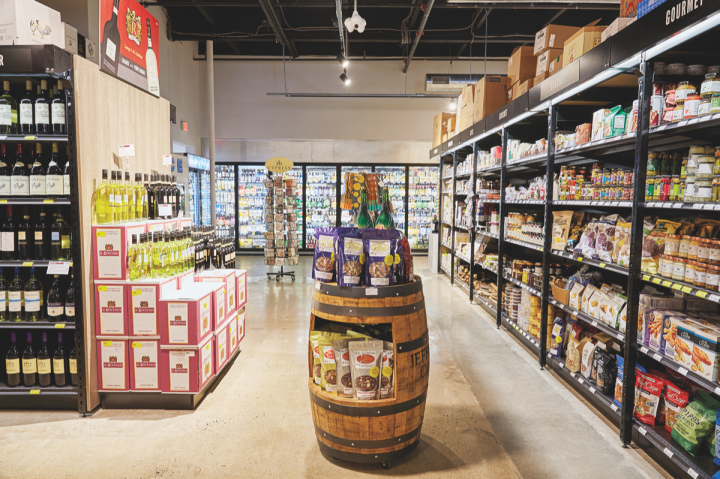
The beverage alcohol retailing world has evolved dramatically over the years, and few independent players have embraced those changes like Gary Fisch. Since first launching his business in 1987—and forgoing a salary for the first four years—Fisch has weathered many storms. His keys to staying relevant are strategic growth and a willingness to continually embrace the changing dynamics of the beverage alcohol retail industry. Those tenets have allowed Fisch, the president and CEO of the five-unit Gary’s Wine & Marketplace in New Jersey, to enjoy more than three decades of growth.
“I’m exceedingly fortunate,” Fisch says. “When we opened in ’87 we had no money, but this industry has been good to me. Back then, New Jersey was just starting to become a wine state, and now it’s one of the best wine markets in the country. Our stores are in great locations, and we keep reinventing.”
Today, Gary’s Wine & Marketplace has five stores in New Jersey, the most recent of which opened in December 2017. Last year, the company’s annual revenue reached $53 million, with wine making up two thirds of total sales. Fisch still enjoys working the sales floor, chatting with customers, and helping people find products, though he admits he doesn’t get much time to do it anymore. These days, Fisch is the big picture guy—and that picture is looking good.
“The first store was 1,200 square feet and did $680,000 for the year,” Fisch says. “Now, we do more than that in a weekend. I always say, ‘We taste bad wine so you don’t have to.’ We may not have the largest selection, but we have the most well-defined selection of everything. When people think of us, they think of a wine shop with great service, great selection, and great prices.”

Facing Challenges
Fisch has watched a lot of buying trends change over the last 30 years. He’s seen the demise of jug wines, the changing perceptions of American whiskies, and the surge in craft beer and spirits. Gary’s Wine & Marketplace has always been active in selling high-end wines, but that business has changed dramatically in recent years with the growth of winery direct sales, Fisch notes. He’s traditionally been among the top buyers at the Premiere Napa Valley auction and has supported Bordeaux futures, but neither sector is what it used to be.
“In Napa, we used to compete against other retailers for allocations, and maybe a restaurant chain,” Fisch says. “Now, we’re competing against other retailers, restaurants, and other countries because Napa has done a great job in Japan and China—plus we’re competing against winery direct sales. Most wineries have been nice enough to maintain an allocation for us so we’re still in the high-end Napa game, but we’ve had to change our approach and it’s frustrating.”
He says that many customers who used to buy ultra-premium Napa wines from him now purchase straight from the wineries, so the stores constantly have to seek out a new audience for those labels. Similarly, Bordeaux futures are still important—and Fisch bought heavily into the 2016 vintage—but they don’t sell as well as they have in the past.
“As long as we can keep introducing new people to these wines, we’ll be okay,” Fisch says. “And now I look for other places to buy wine. I’m taking two trips to Oregon this year to look more closely at Oregon Pinot Noirs, and I’ll probably go to Portugal. We have to do that for our business.”

Fisch predicts that wines from Portugal and Greece will rise in popularity, and adds that he’s also investing more heavily in Chile and Argentina. His private-label wines are surging too, and he plans to grow that portion of the business this year. Fisch offers several tiers of private-label wines, all from California and all bearing names with his initials, from Going Forward ($18 a 750-ml.) to Go Figure ($20-$70) to Grand Finale ($80-$140); he’s also added the Fisch label, which includes a Sauvignon Blanc ($18) and Cabernet Sauvignon ($23) and is launching a rosé this spring ($18).
Overall, the top-selling wines at Gary’s include Santa Margherita Pinot Grigio ($20 a 750-ml.), Veuve Clicquot Brut Champagne ($46), Kendall-Jackson Chardonnay ($12), and Fisch Cabernet Sauvignon ($23). Higher-end labels like Stag’s Leap Wine Cellars Artemis Cabernet Sauvignon ($47) also rank among the company’s top 20 wines. In addition, Fisch notes that rosé sales are still on the rise, having increased more than 20% last year, while sparkling wines are also growing.
The online sales piece continues to evolve, presenting new challenges for Fisch and his team. He describes the online wine business as a moving target, noting that laws change constantly and the states to which he’s allowed to ship vary on a regular basis. Currently, Fisch can ship wine to 13 states. Because of the recent shipping crackdown, he can no longer ship to New York consumers, which has put a dent in his online business.
“Some of the states where we used to ship were our biggest online customers, and now we can’t ship to them,” Fisch says. “It’s a shame for those customers, and a challenging piece of our business. We’re focusing on pick-up and local deliveries. For Bordeaux futures and Napa Cabernets, that’s become a global audience, and we don’t ship internationally. When you take the national sales out of that picture you have to rethink how you sell those wines.”

Increased Competition
Local competition among retailers is also fierce in New Jersey. Larger players are buying up smaller retailers and creating statewide and regional chains. But Fisch maintains that his stores have the best pricing in the state, even though they’re not marketed as discount outets.
“We study pricing to make sure we have the correct products at the correct pricing,” Fisch explains. “Our stores are clean and bright and we have an educated staff. There’s no store in New Jersey, especially one the size of ours, that has a better trained staff.” To illustrate his point, Fisch cites recently hired sommelier Brooke Sabel, who serves as Gary’s wine director and focuses on both staff and consumer education.
Gary’s has nearly 200 employees, including 85 full-time staff. Each store has its own general and assistant managers to complement corporate wine, spirits, and beer buyers and the marketing team. The flagship store in Wayne, New Jersey spans 24,000 square feet and boasts more than 6,000 SKUs, including 3,500 wine SKUs. The locations in Bernardsville and Madison are both 13,000 square feet, while the newer locations in Hillsborough and Closter are roughly 8,500 square feet. Company-wide, wine makes up about 66% of total revenue, followed by spirits at 15% and beer at 11%, with non-alcohol items like gourmet cheeses bringing in the remaining 8%.
The Gary’s unit in Hillsborough opened in summer 2015 and the Closter location debuted in December 2017. Both stores are farther from Fisch’s home base, but he’s been happy with the results. “Hillsborough is doing great,” Fisch says. “The challenge has been the smaller customer base. But it’s growing at a nice pace and we’ve established ourselves for local, everyday consumers. In Hillsborough, we’re now looking to do a better job of capturing the larger wine-savvy audience in nearby towns.”
Meanwhile, Fisch says Closter has been a success from day one. He notes that the store happened very quickly—it opened less than six months after Fisch committed to the space—and pushed his business further geographically than it has ever gone. “Closter is performing better than I could have imagined, and we had high expectations,” Fisch says. “We filled a niche there for a high-end wine shop—the market was begging for it. The demographic there is densely populated with wealthy wine drinkers, who fit our target for sure.”
These newer locations have open ceilings and brushed concrete flooring. Fisch is moving away from large warehouse spaces attached to his stores, so both Hillsborough and Closter have virtually no back room, opting instead for small receiving areas to unload merchandise. “Real estate is very expensive in New Jersey,” he notes. “Having open ceilings allows us to stack products higher and not have a back room.”

Diverse Range
Though wine dominates sales, spirits and beer have healthy sales margins at Gary’s Wine & Marketplace stores. Tequilas and whiskies are both doing well. The company buys several single barrel whiskies a year from a variety of distilleries, and this retailer-exclusive single barrel program has been particularly strong and a customer favorite. Even so, the company’s biggest spirits chainwide are vodkas and Scotches. The top-selling labels include Tito’s Handmade vodka ($29 a 1.75-liter), Ketel One vodka ($39), and Gray’s Peak vodka ($25), as well as Johnnie Walker Black label ($59) and Blue label ($179 a 750-ml.), and Dewar’s White label ($32 a 1.75-liter) blended Scotches.
In beer, craft labels garner the most interest, even though the company’s best-sellers overall are major, well-known brands. Top-performing beers at Gary’s Wine & Marketplace include Stella Artois ($27 a 24-pack of 12-ounce bottles), Corona ($26), Heineken ($27), and Corona Light ($26). Among smaller producers, Founders All Day IPA ($17 a 15-pack of 12-ounce cans), Dogfish Head 60 Minute IPA ($10 a 6-pack of 12-ounce bottles), and Sierra Nevada Pale ale ($30 a 24-pack of 12-ounce bottles) do well.
“Consumers have changed dramatically,” Fisch says. “We’re geared to female consumers. The stores are very comfortable—we aim to be marketplace stores, not just corner liquor stores. We want to be a one-stop shop for all people. And as much as we want to be a boutique wine shop, we’re a mainstream store.”
While Fisch has no plans to open additional stores in the near future, he won’t rule it out. Now that the Closter location has pushed his business so far out geographically, expanding beyond New Jersey is not off the table. But for now, Fisch is focused on growing his current business. He plans to commission a major renovation of the Madison location this summer to upgrade and modernize the space, and he adds that he’ll look into renovating Bernardsville later on.
“It’s important to stay relevant and upgrade and renovate as needed,” Fisch explains. “I still look at the business as small and family-owned, even though we’re not that small anymore. We will continue to evolve and grow, and whatever happens next, we’ll move with it.”